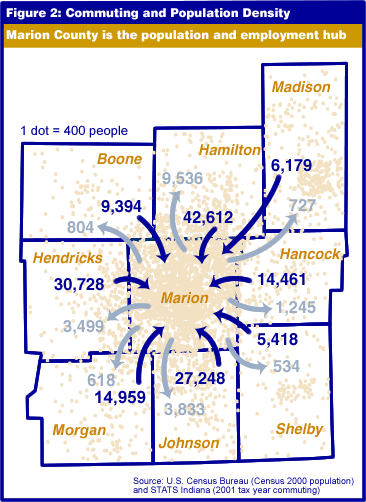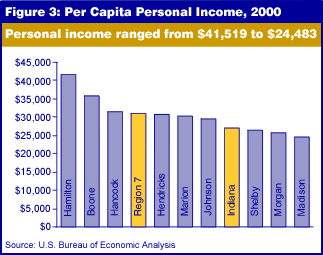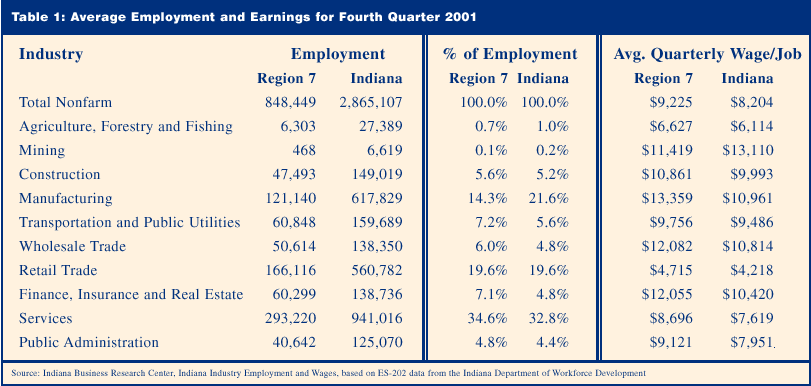Commerce Region Seven: Central Indiana
Readers' Note: With the start of 2003, we have begun using the new regions developed by the Department of Commerce, which vary slightly from the workforce regions highlighted in previous issues. This article focuses on Commerce Region Seven in an effort to continue from where we left off in 2002.
The Area
Commerce Region Seven is comprised of the nine counties that form the Indianapolis Metropolitan Statistical Area (MSA): Boone, Hamilton, Hancock, Hendricks, Johnson, Madison, Marion, Morgan and Shelby. The most prominent cities in the area include Indianapolis, Anderson, Lawrence, Fishers, Carmel, Greenwood and Noblesville.
Population
As the largest and fastest-growing region in the state, Region Seven had slightly more than 1.6 million residents in 2000. Growth during the 1990s was 16.4 percent, significantly higher than the state's rate of 9.7 percent. While Marion County accounts for more than half the region's population (see Figure 1), the largest population growth-both numerically and on a percentage basis-occurred in Hamilton County. It gained 73,804 residents between 1990 and 2000; that's 67.7 percent change. It was, in fact, the fastest growing county in the state. However, one-third of the counties in Region Seven experienced single-digit population growth, with Madison County lagging behind at 2.1 percent.

Industrial Mix and Jobs
Well-known employers in Region Seven include the State of Indiana, Eli Lilly & Co., Clarian Health Partners, Central Indiana Health Systems, Anthem, Conseco, Rolls-Royce Allison, IUPUI, St. Vincent Hospitals and Health Services and Wishard Health Services.
Marion County is the employment hub for the region, as the commuting arrows in Figure 2 show. In 2001, the number of commuters into Indianapolis ranged from 42,612 out of Hamilton County to just 5,418 from Shelby County. In addition, nearly 460,000 people both lived and worked in Marion County.

In the five years between November 1997 and November 2002, total non-farm employment in Region Seven increased 4.6 percent, surpassing the state's growth of 1.1 percent. While the Indianapolis MSA fared better than many other areas in the state during the recent recession, it was not unscathed; the bankruptcies of United Airlines and Carmel-based Conseco hit the region particularly hard, putting thousands of jobs in jeopardy.
As of November 2002, Region Seven was dominated by service-producing jobs, a condition not likely to change. Only 13.5 percent of jobs were in the manufacturing sector (this was much lower than the state's 21.1 percent). The services industry accounted for 28.6 percent of jobs, followed by trade with 25.8 percent. The health services sector is a significant player in the region, as evidenced by the presence of nationally renowned hospitals, medical research facilities and companies in the health care industry. The Central Indiana Life Sciences Initiative created last year is likely to further develop Region Seven as a center for medical research and production.
Income and Wages
Per capita personal income was $30,906 for Region Seven in 2000. This was higher than any other region or MSA in the state and almost $4,000 more than the state average. Per capita personal income in the individual counties ranged from $41,519 in Hamilton (the highest in the state) to $24,483 in Madison County (see Figure 3).

As seen in Table 1, the average quarterly wage per job was $9,225 for the fourth quarter of 2001. Manufacturing workers earned the most ($13,359), while those in retail trade earned a mere $4,715 for the quarter. However, even the retail workers in Region Seven earned roughly $500 more than their counterparts in the rest of the state. While quarterly wages were higher in Region Seven for all sectors except mining, workers in the manufacturing sector experienced the largest differential, earning about $2,400 more than the state average.

Rachel Justis
InContext Managing Editor, Indiana Business Research Center,
Kelley School of Business, Indiana University
